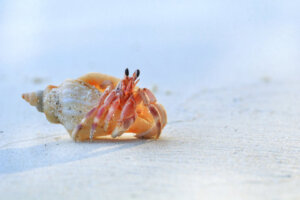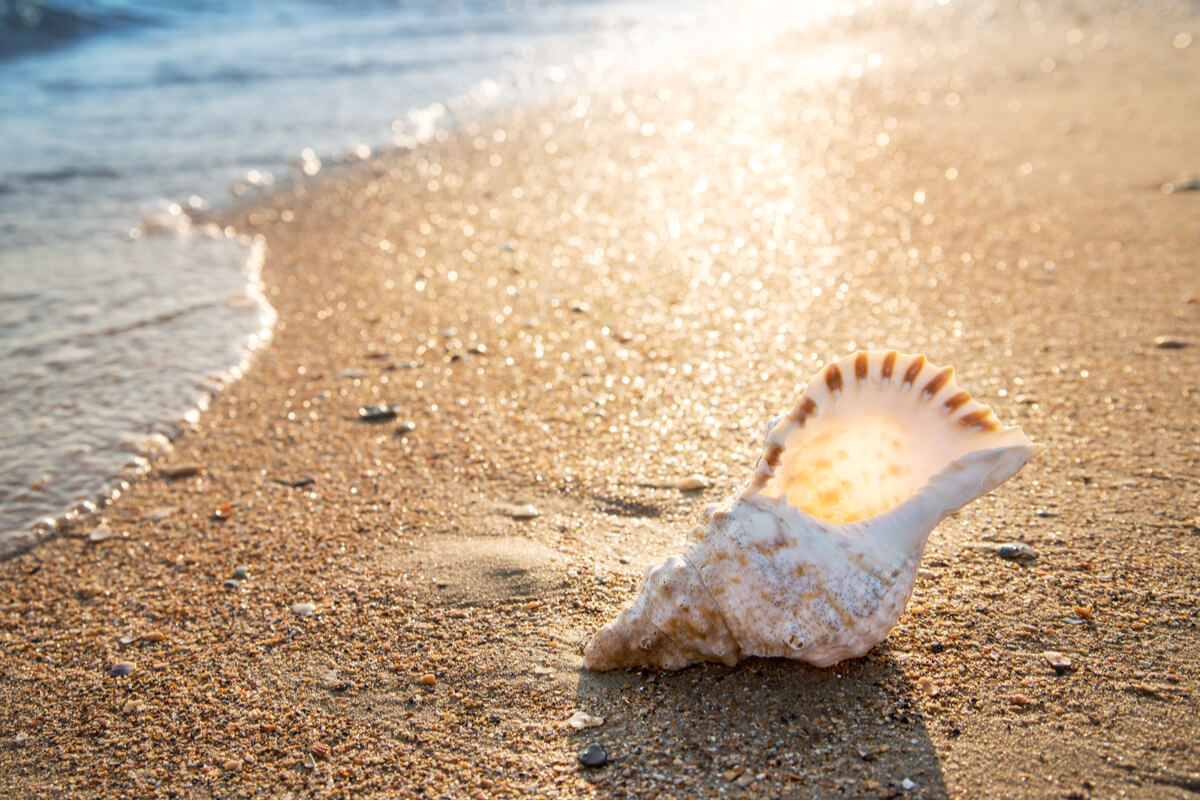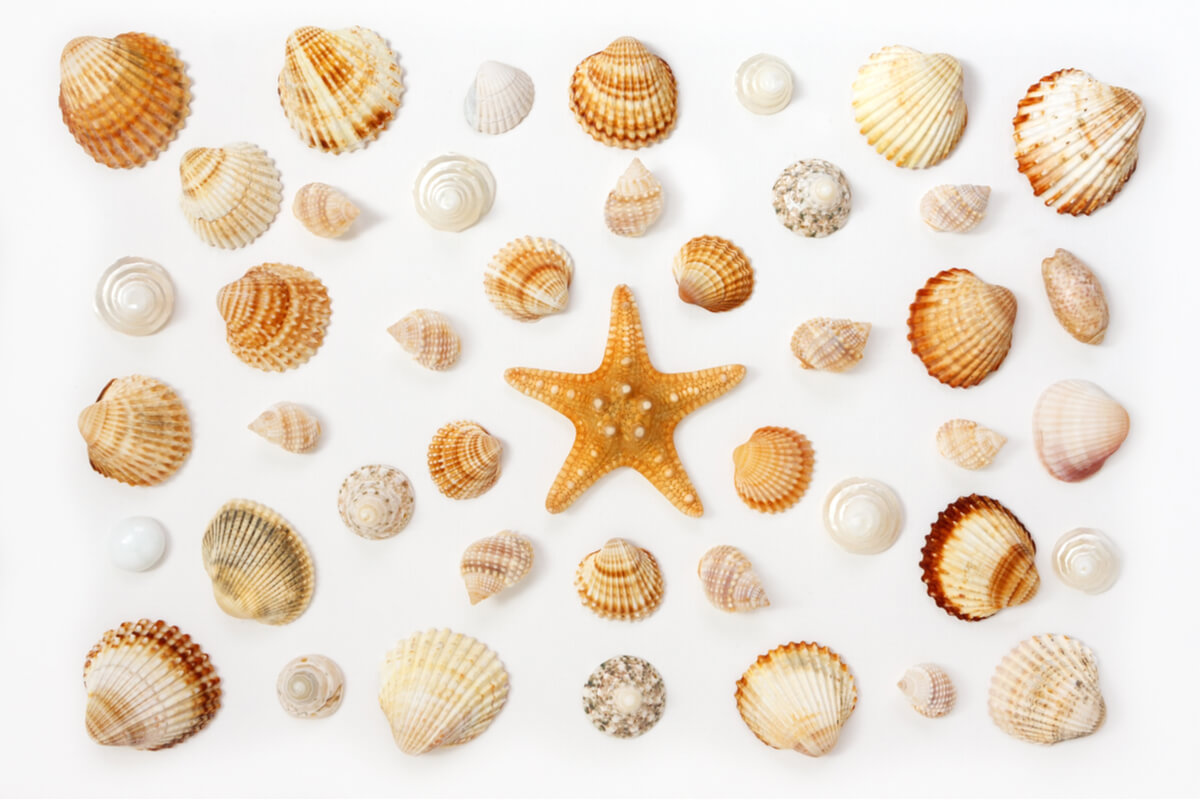Is it Wrong to Take Shells from the Beach?


Written and verified by the biologist Ana Díaz Maqueda
Although it may seem to us that beaches are poor ecosystems, when it comes to species richness, this isn’t the case. For example, although shells may seem to us to be just the remains of what were once animals, they’re actually crucial to the balance and regeneration of this type of environment. So, have you ever wondered whether it’s wrong to take shells from the beach?
You may not have even thought about it, but taking these exoskeletons en masse can wreak havoc on marine ecosystems. Likewise, even though you may think that taking a single shell isn’t the problem, you aren’t the only person who’ll do it. We’ll tell you more about the importance of shells on beaches and why it’s best to leave them where they are!
Seashells are an important part of coastal ecosystems
Beach ecosystems are a fundamental part of a much larger biome, the oceans. We could go even further and say that they’re also key to the thermoregulation of the planet and they influence the global climate.
Among other things, beach sand is made up of inert debris carried by rivers. It’s basically made up of more or less eroded seashells and plant debris, as is the case with Posidonia oceanica on the Mediterranean coasts.
Although one might think that it isn’t wrong to take shells from the beach, it actually has very negative consequences for the environment, due to the important role of these elements. Some of the functions of seashells are:
- To provide good nesting material for seabirds. In addition, some invertebrates use them as protective housing.
- As a good, firm surface for seaweed to attach to so they aren’t so easily carried away by currents. Likewise, they serve seagrasses (Posidonia oceanica), sponges and other microorganisms.
- For fish to use them for shelter and to throw off predators.
- Spiral-shaped shells are essential for hermit crabs.
- They restrain the transportation of various particles such as pollutants, heavy metals, and calcium carbonate.
- With the passage of time and erosion, they’ll come to form the shells of future organisms and part of the beach sand.

The disappearance of seashells and tourism
Many marine biology departments of different universities study biodiversity in intertidal zones. These are areas that are covered with water at high tide and dry at low tide.
For some years now they have found that there’s a steady decline in species richness and biodiversity, but why? A study conducted on a beach in Spain by the University of Florida discovered the cause.
The most striking aspect the research brought to light was the drastic reduction in the number of shells on the beaches over a 30-year period. In this time range, the presence of shells had been reduced by 60%, while the influx of tourism had increased by 300%.
Also, thanks to the research, it was discovered that it was during the summer months that the number of shells was most depleted. This shows that humans are the main culprits in the disappearance of shells from beaches and its consequences.
The problem of beach tractors
Every night, on many beaches that are crowded with people during the day, huge tractors pass by to clean them of human waste. This type of machinery has another effect: the destruction of shells due to its heavy tonnage.
Nevertheless, more studies need to be carried out to see how human actions have different effects on the world’s beaches. What is true is that people tend to take shells from the beach without thinking or realizing the consequences of their actions.
Is it right to take shells from the beach?
Beaches are ecosystems in a constant process of destruction, but also of construction. Waves and tides destroy beaches and, in turn, bring sediment and organic debris to rebuild them. In short, it’s a constantly changing and highly resilient environment. Because of this, external actions, such as those of humans, have wreaked havoc on coastal ecosystems. Some examples of this are:
- Urbanization on the coastline.
- The destruction of natural coastal sites for the construction of hotels.
- The use of beach sand as construction material.
- Predation and extirpation of species (removing shells, pieces of coral, starfish, fish, and other animals from the beach).
- The constant flow of contamination, sewage, pollution, and toxic waste.
All these facts mean that, for many animals, life on the beach is no longer safe. In some cases, these animals have been able to move to other places, but sometimes they have had no choice but to disappear.
As we saw, another problem of coastal ecosystems is the collection of seashells by humans. It may seem to you that there are so many shells and that taking one or two won’t be a problem. That may be so, but thousands of other people will be thinking the same. Taking shells from the beach is unethical and could even contribute to climate change.

How are shells related to climate change?
Incredible as it may seem, shells are also a link in the complex process of biogeochemical cycles. These cycles are responsible for recycling and maintaining the stability of molecules essential for life. Thanks to them, resources become available to all animals in the food chain. This is of utmost importance in the sea, as the ocean traps much of the CO₂ that exists.
However, biogeochemical cycles are regulated by several steps, the most important of which is the reintegration of nutrients into the environment. The latter is what happens when the shell stays on the beach and disintegrates over time, but this process is interrupted if someone takes it home to accumulate dust or end up in the trash.
Shells are part of the delicate balance formed by the networks between the hundreds of organisms that can coexist on the same beach. That shell you find so precious could become a good home for a hermit crab or for seaweed to attach itself to. It could also provide the nutrients needed for marine animals to thrive. However, when you take it off the beach, none of this can occur.
The best thing to do the next time you see a shell you like is to take a picture of it. This way, you’ll take its image away as a souvenir without taking away a shell that other living beings could use. Remember that our actions could affect the planet more than we can imagine.
Although it may seem to us that beaches are poor ecosystems, when it comes to species richness, this isn’t the case. For example, although shells may seem to us to be just the remains of what were once animals, they’re actually crucial to the balance and regeneration of this type of environment. So, have you ever wondered whether it’s wrong to take shells from the beach?
You may not have even thought about it, but taking these exoskeletons en masse can wreak havoc on marine ecosystems. Likewise, even though you may think that taking a single shell isn’t the problem, you aren’t the only person who’ll do it. We’ll tell you more about the importance of shells on beaches and why it’s best to leave them where they are!
Seashells are an important part of coastal ecosystems
Beach ecosystems are a fundamental part of a much larger biome, the oceans. We could go even further and say that they’re also key to the thermoregulation of the planet and they influence the global climate.
Among other things, beach sand is made up of inert debris carried by rivers. It’s basically made up of more or less eroded seashells and plant debris, as is the case with Posidonia oceanica on the Mediterranean coasts.
Although one might think that it isn’t wrong to take shells from the beach, it actually has very negative consequences for the environment, due to the important role of these elements. Some of the functions of seashells are:
- To provide good nesting material for seabirds. In addition, some invertebrates use them as protective housing.
- As a good, firm surface for seaweed to attach to so they aren’t so easily carried away by currents. Likewise, they serve seagrasses (Posidonia oceanica), sponges and other microorganisms.
- For fish to use them for shelter and to throw off predators.
- Spiral-shaped shells are essential for hermit crabs.
- They restrain the transportation of various particles such as pollutants, heavy metals, and calcium carbonate.
- With the passage of time and erosion, they’ll come to form the shells of future organisms and part of the beach sand.

The disappearance of seashells and tourism
Many marine biology departments of different universities study biodiversity in intertidal zones. These are areas that are covered with water at high tide and dry at low tide.
For some years now they have found that there’s a steady decline in species richness and biodiversity, but why? A study conducted on a beach in Spain by the University of Florida discovered the cause.
The most striking aspect the research brought to light was the drastic reduction in the number of shells on the beaches over a 30-year period. In this time range, the presence of shells had been reduced by 60%, while the influx of tourism had increased by 300%.
Also, thanks to the research, it was discovered that it was during the summer months that the number of shells was most depleted. This shows that humans are the main culprits in the disappearance of shells from beaches and its consequences.
The problem of beach tractors
Every night, on many beaches that are crowded with people during the day, huge tractors pass by to clean them of human waste. This type of machinery has another effect: the destruction of shells due to its heavy tonnage.
Nevertheless, more studies need to be carried out to see how human actions have different effects on the world’s beaches. What is true is that people tend to take shells from the beach without thinking or realizing the consequences of their actions.
Is it right to take shells from the beach?
Beaches are ecosystems in a constant process of destruction, but also of construction. Waves and tides destroy beaches and, in turn, bring sediment and organic debris to rebuild them. In short, it’s a constantly changing and highly resilient environment. Because of this, external actions, such as those of humans, have wreaked havoc on coastal ecosystems. Some examples of this are:
- Urbanization on the coastline.
- The destruction of natural coastal sites for the construction of hotels.
- The use of beach sand as construction material.
- Predation and extirpation of species (removing shells, pieces of coral, starfish, fish, and other animals from the beach).
- The constant flow of contamination, sewage, pollution, and toxic waste.
All these facts mean that, for many animals, life on the beach is no longer safe. In some cases, these animals have been able to move to other places, but sometimes they have had no choice but to disappear.
As we saw, another problem of coastal ecosystems is the collection of seashells by humans. It may seem to you that there are so many shells and that taking one or two won’t be a problem. That may be so, but thousands of other people will be thinking the same. Taking shells from the beach is unethical and could even contribute to climate change.

How are shells related to climate change?
Incredible as it may seem, shells are also a link in the complex process of biogeochemical cycles. These cycles are responsible for recycling and maintaining the stability of molecules essential for life. Thanks to them, resources become available to all animals in the food chain. This is of utmost importance in the sea, as the ocean traps much of the CO₂ that exists.
However, biogeochemical cycles are regulated by several steps, the most important of which is the reintegration of nutrients into the environment. The latter is what happens when the shell stays on the beach and disintegrates over time, but this process is interrupted if someone takes it home to accumulate dust or end up in the trash.
Shells are part of the delicate balance formed by the networks between the hundreds of organisms that can coexist on the same beach. That shell you find so precious could become a good home for a hermit crab or for seaweed to attach itself to. It could also provide the nutrients needed for marine animals to thrive. However, when you take it off the beach, none of this can occur.
The best thing to do the next time you see a shell you like is to take a picture of it. This way, you’ll take its image away as a souvenir without taking away a shell that other living beings could use. Remember that our actions could affect the planet more than we can imagine.
All cited sources were thoroughly reviewed by our team to ensure their quality, reliability, currency, and validity. The bibliography of this article was considered reliable and of academic or scientific accuracy.
- Defeo, O., McLachlan, A., Schoeman, D. S., Schlacher, T. A., Dugan, J., Jones, A., … & Scapini, F. (2009). Threats to sandy beach ecosystems: a review. Estuarine, coastal and shelf science, 81(1), 1-12.
- Goldman, J. (2014). Leave seashells on the seashore or risk damaging ecosystem, says study. The Guardian. Disponible en: https://www.theguardian.com/environment/2014/may/19/shells-beach-decline-ecosystem-marine-life#:~:text=Leave%20seashells%20on%20the%20seashore%20or%20risk%20damaging%20ecosystem%2C%20says%20study,-Beachcombers%20and%20beach&text=In%20a%20study%20more%20than,on%20shells%20for%20their%20survival.
- Kowalewski, M., Domènech, R., & Martinell, J. (2014). Vanishing clams on an Iberian beach: local consequences and global implications of accelerating loss of shells to tourism. PloS one, 9(1), e83615.
- Speybroeck, J., Bonte, D., Courtens, W., Gheskiere, T., Grootaert, P., Maelfait, J. P., … & Lancker, V. V. (2006). Beach nourishment: an ecologically sound coastal defence alternative? A review. Aquatic conservation: Marine and Freshwater ecosystems, 16(4), 419-435.
- Bianchi, A. A., Osiroff, A. P., Balestrini, C. F., Piola, A. R., & Perlender, H. I. (2010). Atrapando C02 en el mar patagónico. Ciencia Hoy, 20 (119).
- Gutiérrez, J. L., Jones, C. G., Strayer, D. L., & Iribarne, O. O. (2003). Mollusks as ecosystem engineers: the role of shell production in aquatic habitats. Oikos, 101(1), 79-90.
- University of Florida. (2014). Study: Seashell loss due to tourism increase may have global impact. Recuperado el 20 de julio de 2022, disponible en: https://phys.org/news/2014-01-seashell-loss-due-tourism-global.htm
This text is provided for informational purposes only and does not replace consultation with a professional. If in doubt, consult your specialist.








